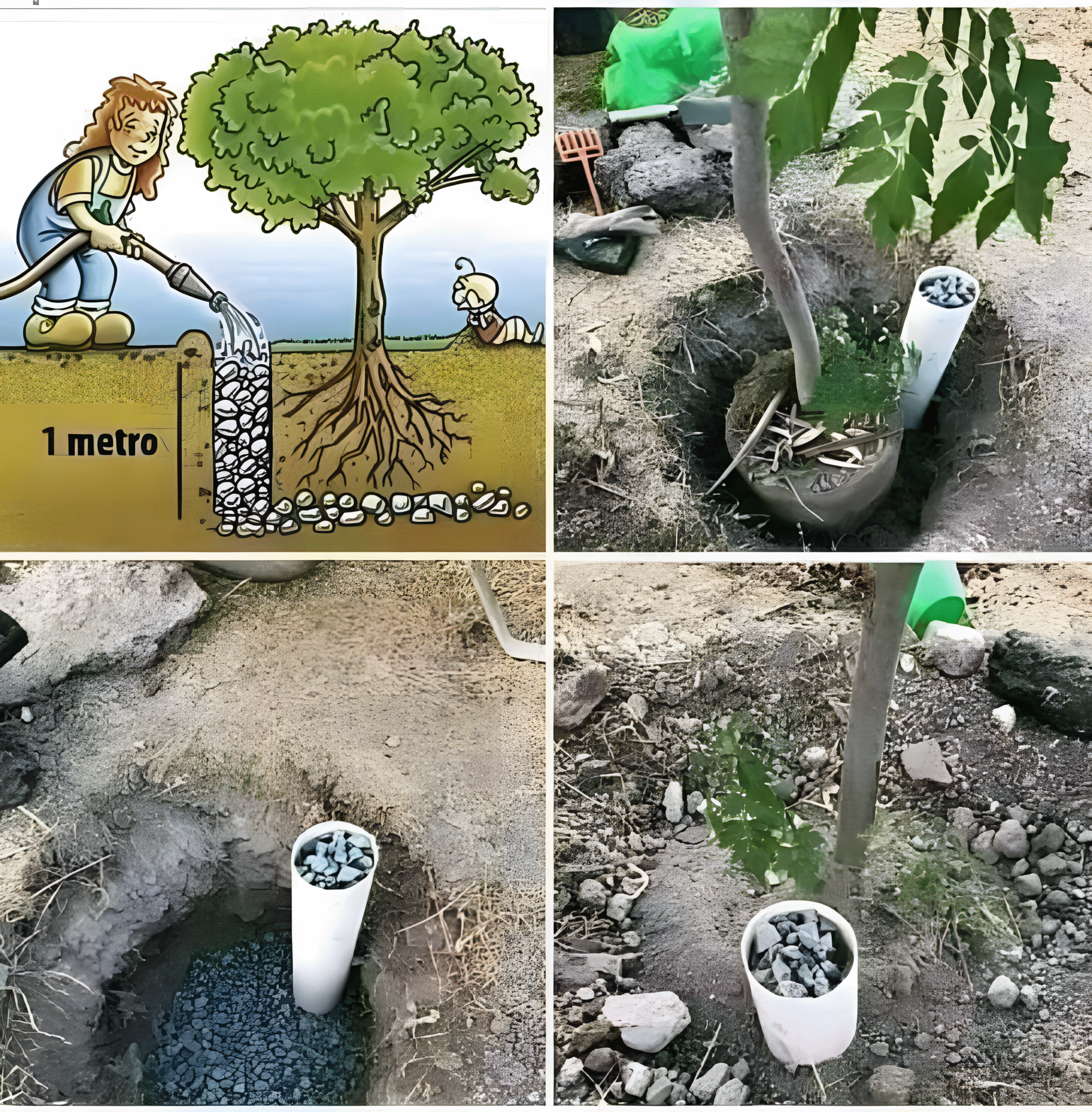By: Green Earth Chronicle | August 5, 2025
In an age where droughts, water shortages, and extreme heat are threatening ecosystems worldwide, a simple, cost-effective method is making waves among environmentalists and home gardeners. Known as the “Deep Watering Pipe System”, this technique allows for efficient hydration of tree roots by delivering water directly to the deeper root zones.
The image above, part diagram and part field implementation, illustrates a step-by-step method of installing a deep watering system beside young or newly planted trees. This method is inexpensive, requires minimal tools, and delivers incredible benefits for root development, water efficiency, and tree health.
Let’s dive into how to recreate this deep watering system — step by step — and why it’s a game-changer for reforestation, urban gardening, and sustainable landscaping.
Understanding the Concept
Traditionally, surface watering leads to shallow root growth. Water often evaporates or runs off before it penetrates deep into the soil. This makes trees vulnerable during hot spells or in poor soil conditions.
The solution? Deliver water directly 1 meter below ground, where roots can access moisture longer. This method, shown in the illustrated panel and photo sequence, uses a vertical pipe filled with gravel that channels water directly downward and encourages deep root growth.
Benefits at a Glance
- Water Efficiency: Reduces waste through evaporation and runoff.
- Root Development: Encourages trees to grow deep, stable roots.
- Soil Improvement: Keeps subsoil hydrated for microbial activity.
- Low Cost: Uses widely available materials (PVC pipe, gravel).
- Climate Resilience: Helps trees withstand heatwaves and drought.
Materials You’ll Need
- PVC pipe (approx. 3 to 4 inches in diameter, 1 meter long)
- Coarse gravel or crushed stone
- Shovel or digging tools
- Tree seedling or sapling
- Organic mulch or compost (optional, but recommended)
- Water source (hose or watering can)
Step-by-Step Installation Guide
Step 1: Dig the Hole (As shown in lower left image)
Start by digging a deep planting hole for your tree. Ideally, the hole should be:
- 1 meter deep to accommodate the root ball and allow for drainage.
- Wide enough to fit both the tree’s roots and the watering pipe.
Beside the main hole, dig a narrow channel for the pipe — about 10–15 cm wide and 1 meter deep.
Step 2: Install the PVC Pipe
Place the PVC pipe vertically in the narrow channel next to the tree hole.
- Ensure the pipe reaches about 1 meter below ground.
- The top of the pipe should stick out of the ground by 5–10 cm for easy access.
- You can pre-drill small holes along the lower ½ of the pipe to increase water dispersion (optional).
Step 3: Fill Pipe and Hole with Gravel (As shown in top left & lower left images)
- Pour coarse gravel into the pipe until it’s filled to the top.
- You may also place gravel in the bottom of the planting hole for drainage.
The gravel acts as a conduit and filter, allowing water to seep slowly and directly to the root zone.
Step 4: Plant the Tree (Top right image)
Carefully plant your tree next to the pipe:
- Position the root ball comfortably in the main hole.
- Backfill with nutrient-rich soil or compost.
- Ensure the tree stands upright and firmly supported.
Avoid compacting the soil too tightly — roots need airflow to thrive.
Step 5: Add Final Gravel and Soil Layers (Bottom right image)
Top off the surrounding area with a layer of gravel or mulch to:
- Reduce evaporation
- Discourage weeds
- Improve aesthetics
Be sure to leave the pipe open and visible, so you can access it for watering.
How to Use the Deep Watering System
Instead of watering around the base of the tree, simply pour water directly into the pipe.
- This method delivers hydration straight to the root zone (around 1 meter deep).
- It requires less water than traditional surface watering.
- You can also mix in liquid compost or slow-release nutrients via the pipe.
In arid regions, this method ensures maximum water retention and minimal waste.
Maintenance Tips
- Check for clogs in the pipe occasionally. Remove debris or sediment if needed.
- Water 1–2 times per week, depending on your climate and rainfall.
- Keep the pipe’s top covered with a mesh or small stone to prevent debris from falling in.
Real-World Applications and Success Stories
This deep watering method is used extensively in reforestation projects, urban landscaping, and dry-climate farming around the world. Farmers and gardeners in Mexico, India, and parts of Africa have seen survival rates of saplings increase by over 60% using this system.
In urban environments, where soil compaction is common and water is scarce, this method has helped city trees grow faster, stay healthier, and resist stress.
Variations and Enhancements
You can customize this system for larger installations or different settings:
- Use multiple pipes around larger trees for uniform watering.
- Add a perforated pipe with a cap to convert it into a mini-reservoir.
- Use clay pots or olla-style inserts instead of PVC for traditional methods.
Conclusion: A Small Pipe, A Big Impact
In the face of a warming planet, small changes in how we plant and water can yield massive benefits. The deep watering pipe method, as illustrated in the image, is proof that simple, affordable, and natural solutions still hold the key to resilient landscapes.
Whether you’re planting a tree in your backyard, launching a community orchard, or reviving soil in drylands, this system ensures every drop counts — and every root reaches its full potential.
